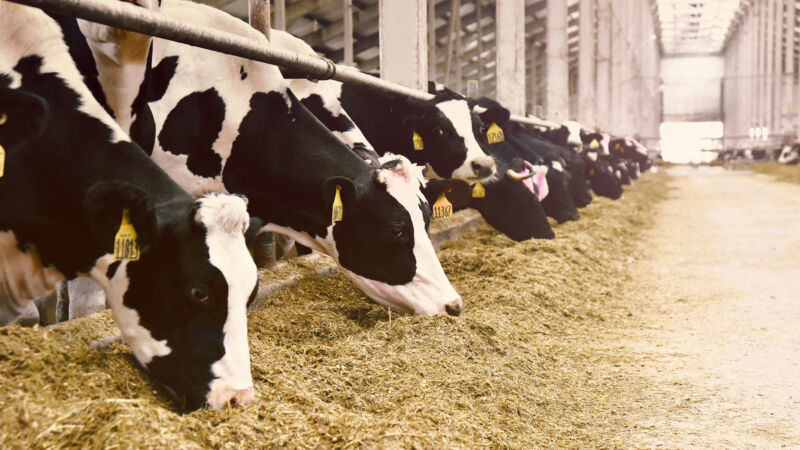
Hans Meleman | Getty Images
It’s an oppressively hot morning in the barnyard, even in the shade of the long open-air structure where the cows come to feed. On a typical farm, they would gather around a trough, but here at UC Davis they chow from special blue bins, which detect when and how much each one eats. It’s like Weight Watchers, only researchers here aren’t so much interested in these cows’ figures, but how much they burp.
Animal scientist Frank Mitloehner leads me to another kind of feeder, one that could easily be mistaken for a miniature wood chipper. He grabs a handful of the alfalfa pellets that the machine dispenses when it detects that a cow has poked its head in. “This is like candy to them,” Mitloehner says. I stick my head into the machine as Mitloehner points out a small metal tube within: “This probe measures the methane they exhale, and that happens every three hours for all the animals in this study.”

Cows, you see, have a serious emissions problem. To digest tough plant material, their cavernous stomachs act as fermentation vats. They’re teeming with methanogens, microbes that process cellulose to make volatile fatty acids, which the cows turn into meat and milk. But those methanogens also produce methane, a particularly nasty greenhouse gas that is 80 times more potent than carbon dioxide, thanks to the way its molecules vibrate to absorb infrared radiation. These gases capture heat, and that means more global warming.
“The methane is a byproduct—an unintended consequence, I’d say—of the unique ability of ruminant animals to digest cellulose,” says Mitloehner. But just because cows can eat it doesn’t mean it’s easy for them. Because the plants cows eat are nutritionally poor, the animals have to eat a lot of food to survive, and periodically bring it back up from their four stomachs to ruminate it again—that’s “chewing the cud.” That leads to incessant burping or, as scientists call it, enteric emissions.
Now multiply those burps by the world’s huge cattle population. To satisfy humanity’s bottomless appetite for beef and milk, a billion head of cattle now roam the planet. A paper published in September in the journal Nature Food by an international team of researchers found that the global food system generates a staggering 35 percent of total greenhouse gas emissions. Beef is responsible for a quarter of those food emissions, with another 8 percent coming from milk production.
However, methane lasts only for about a decade in the atmosphere, while carbon dioxide persists for centuries. If scientists can figure out how to get cows to stop belching so much, that would make a big dent in emissions, and we’d see the climate effects almost immediately. So Mitloehner and other researchers are experimenting with food additives like seaweed, garlic, and even essential oils derived from plants like coriander seed, which tweak the animals’ gut environment in different ways, for instance by disrupting the enzymes that produce methane. They’re also playing around with biochar—charcoal, basically—which soaks up methane in the gut.
That’s why Mitloehner is going to such lengths to quantify his cows’ diets: Using the high-tech troughs and snack-dispensing methane detectors, he can show how well a particular technique might reduce enteric emissions. “We have found that, depending on what additive you are dealing with, we can reduce enteric emissions anywhere between 10 to 50 percent, and that is sensational,” says Mitloehner.
Earlier this year, a team co-led by his UC Davis colleague, animal scientist Ermias Kebreab, published research showing a gas reduction of up to 82 percent with seaweed additives. But studies from scientists testing other additives have shown lower degrees of effectiveness. A 2019 study from Wageningen University and Research that looked at the organic compound 3-nitrooxypropano, or 3-NOP, found up to a 50 percent reduction. One by researchers in the UK and Switzerland found that Agolin, a mixture of essential oils, reduced methane production by only 6 percent. In New Zealand, cows fed tannins showed a 13 percent reduction.
And the concept of rolling out a feed additive to the world’s billion cows faces some logistical challenges. “The truth is that the benefits of seaweed are likely far more limited, both in its capacity to reduce cows’ methane emissions and its potential to scale up to the size of the problem,” wrote researchers Matthew Hayek and Jan Dutkiewicz in WIRED earlier this year. They noted that cows produce the most methane when they’re grazing in a pasture, eating all that grass—the hard-to-digest stuff. That’s where most cattle spend most of their lives; they live on feedlots, where it would be easy to add additives to their diets, only in their final months when they are being fattened for slaughter. The researchers estimated that cows belch just 11 percent of their lifetime methane during those months on feedlots.
That’s an issue, Mitloehner acknowledges. “The challenge will be to get these into free-range cattle that are not fed at a trough,” he says. “One way might be via salt licks, or maybe via drinking water. Work is also ongoing to put these active ingredients into a slow-release bolus to be placed in the cow’s stomach system.”
He also wants to avoid side effects. “The higher you go with your [emissions] reduction, the more likely you are to run into unintended consequences,” he says. For instance, the researchers have to track the animals’ weight to make sure the additive isn’t affecting growth. They also have to consider palatability—maybe cows don’t like their food tasting like garlic. Or the animal might end up burping less, but their milk could come out tasting weird. “We have to find out what the happy medium is,” he says.








